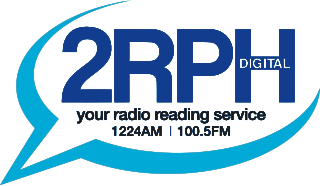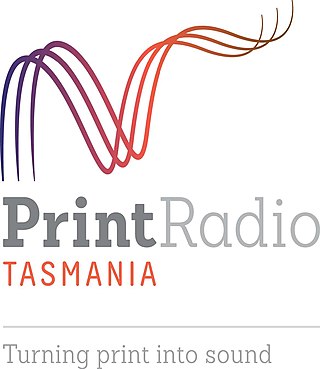Related Research Articles

Television broadcasting in Australia began officially on 16 September 1956, with the opening of TCN-9, quickly followed by national and commercial stations in Sydney and Melbourne, all these being in 625-line black and white. The commencement date was designed so as to provide coverage of the Olympic Games in Melbourne. It has now grown to be a nationwide system that includes a broad range of public, commercial, community, subscription, narrowcast, and amateur stations.

Radio 1RPH 1125 kHz Canberra is a volunteer-staffed AM band radio broadcast station in the Australian Capital Territory serving all of the ACT and surrounding areas of NSW including Queanbeyan, Yass and Michelago, with FM repeaters at Wagga and Junee, and a streaming media on its web site.
RPH Australia is the national peak representative organisation for a unique Australian network of radio reading services designed to meet the daily information needs of people who, for any reason, are unable to access printed material. It is estimated that 22% of the Australian population has a print disability.

Community radio is a radio service offering a third model of radio broadcasting in addition to commercial and public broadcasting.
The Community Broadcasting Association of Australia (CBAA) is the peak body and the national representative organisation for community radio and television stations in Australia. The CBAA provide leadership, advocacy and support for members to actively provide independent broadcasting services and to build and strengthen local communities. The organisation provides advice and support to community broadcasters regarding a variety of issues.
Religious broadcasting, sometimes referred to as faith-based broadcasts, is the dissemination of television and/or radio content that intentionally has religious ideas, religious experience, or religious practice as its core focus. In some countries, religious broadcasting developed primarily within the context of public service provision, whilst in others, it has been driven more by religious organisations themselves. Across Europe and in the US and Canada, religious broadcasting began in the earliest days of radio, usually with the transmission of religious worship, preaching or "talks". Over time, formats evolved to include a broad range of styles and approaches, including radio and television drama, documentary, and chat show formats, as well as more traditional devotional content. Today, many religious organizations record sermons and lectures, and have moved into distributing content on their own web-based IP channels.

2RPH is an Australian radio reading service that reads newspapers and magazines for the benefit of those who have difficulties reading for themselves. It is the Sydney station of the RPH Network.

6RPH Vision Australia Radio broadcasts on 990 kHz AM and was previously owned and operated by the Foundation for Information Radio of Western Australia Inc. It now broadcasts Vision Australia Radio and aims to provide access to printed information for Western Australians with a print disability. Vision Australia Radio is a member of RPH Australia.
Imparja Television (IMP) is an independent Australian television station servicing over 3,600,000 km2 (1,400,000 sq mi), across six states and territories: Northern Territory, South Australia, Queensland, New South Wales, Victoria and Tasmania. It is based in Alice Springs, and is controlled by Aboriginal people through ownership by Imparja Television Pty Ltd.
Digital-television radio, DTV radio, or DTR describes the audio channels that are provided with a digital television service. These channels are delivered by cable television, direct-broadcast satellite or digital terrestrial television. In terms of variety, DTR falls somewhere between regular AM and FM radio, and satellite radio. However, because it is delivered through a digital signal, the actual sound quality can exceed both.

The Voice of Vietnam or VOV is the Vietnamese national radio broadcaster. Directly controlled by the government of Vietnam, it is tasked propagating the policies of the Party and the laws of the state.
Optus Aurora was a free-to-view satellite television platform in Australia, which aimed at providing television and radio services to remote and black spot areas using the Optus C1 and B3 satellites. The service was available in all areas, using a standard satellite dish and set top box, however commercial stations carried on the platform were restricted to their respective coverage areas.

The Aboriginal Peoples Television Network is a Canadian specialty channel. Established in 1992 and maintained by governmental funding to broadcast in Canada's northern territories, APTN acquired a national broadcast licence in 1999. It airs and produces programs made by, for and about Indigenous peoples in Canada and the United States. Based in Winnipeg, Manitoba, it is the first network by and for North American indigenous peoples.

Print Radio Tasmania is a radio station based in Hobart, Tasmania. It is a reading and information service for those persons unable to read or easily access information in print. The station is run and operated by volunteers.
Vision Australia Radio is a network of eight radio stations in Victoria, amongst some other states in Australia. It is owned by Vision Australia. The stations broadcast a range of programs, generally consisting of readings of newspapers and magazines for people unable to read print media. All the stations are operated by a volunteer staff and a small group of employees.

FM 91.1 CMS is a multilingual community radio station broadcasting to Canberra, in languages other than English, from studios in the suburb of Holder. CMS is a member of the National Ethnic and Multicultural Broadcasters Council (NEMBC) and the Community Broadcasting Association of Australia (CBAA).
Radio Blue Mountains 89.1 is a not-for-profit, all volunteer community radio station serving the Blue Mountains since 1993. The station broadcasts 24 hours a day from its studio in Katoomba, to a potential audience of some 75,000 people across the Blue Mountains and to a much wider national and international audience through internet streaming.
The Community Broadcasting Foundation (CBF) is an independent non-profit funding organisation based in Melbourne. The CBF receives funds from the Australian Government to distribute through grant programs to support the maintenance and development of community broadcasting in Australia.
The National Indigenous Radio Service (NIRS) is a satellite program feed available in Australia to Indigenous and non-Indigenous community radio stations. NIRS provides targeted and specialist programming for and by Australia's Aboriginal and Torres Strait Islander broadcasters. From its base in Brisbane NIRS provides a feed of programs and music supplied by a number of contributing stations including Koori Radio, 4AAA and BBM.
The Viewer Access Satellite Television service, or VAST, is a satellite television platform in Australia, providing digital television and radio services to remote and rural areas, as well as viewers in terrestrial black spots. The service uses the Optus C1 and Optus D3 satellites. It is partly funded by the Australian Government and managed through a joint-venture between Southern Cross Media and Imparja Television. It is an even more restricted free-to-view replacement for Optus Aurora providing channels which have been absent on the remote service until now. The platform uses only H.264 video encoding and 8PSK, which allows for more lower bit rate channels on the limited transponder space that's available. The EPG uses an MHEG-5 guide instead of the usual more compatible DVB EIT.
References
- ↑ Nicky Page (2000-05-17). "Hidden Assets in Community Radio" (PDF). Adult Learning Australia. Archived from the original (PDF) on September 19, 2007. Retrieved 2008-07-18.
- ↑ Dr Bob Pymm (2008). "Satellite capture of broadcast material" (PDF). VALA]. Retrieved 2008-07-18.
- ↑ "What is it?". CBAA. 2008. Archived from the original on 2008-07-19. Retrieved 2008-07-18.
- ↑ "The Satellite Story". CBAA. 2008. Archived from the original on 2008-08-07. Retrieved 2008-07-18.
- ↑ "Screen Australia radio program". Screen Australia. 2008. Archived from the original on 2009-07-13. Retrieved 2008-07-18.
- ↑ "CBF guidelines for equipment grants". Community Broadcasting Foundation. 2008. Retrieved 2008-07-18.
- ↑ "About DDN". CBAA. 2008. Archived from the original on 2008-07-19. Retrieved 2008-07-18.